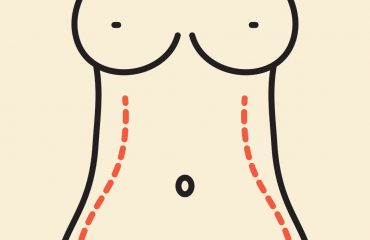Well-contoured hips and buttocks are generally recognised marks of beauty in a woman. Long and well-shaped legs that end in a firm, round butt are the dream of men and women alike. The picture is completed with a shapely small of the back, small waist and tight belly. Leg length and hip width are genetically determined and cannot be changed. However, defects can be corrected, the soft tissue can be shaped and the overall looks can be maintained and preserved.
Frequently asked questions about buttock augmentation:
What is buttock augmentation?
It is a procedure to reshape and enhance the gluteal area and adjacent parts of the lower body, hips, waist and lower abdomen. The goal is to lift and contour the buttocks, to remove undesirable fat deposits and skin excess, and to reduce and contour the waist. The procedure includes liposuction (link) and may be combined with liposhaping (link), and the use of silicone implants where necessary. After massive weight loss, the buttocks and the lower abdomen are lifted and excess skin is removed.
Who is a good candidate for buttock augmentation?
Everyone who is not satisfied with their gluteal area. Most patients desire firmer, rounder and more shapely buttocks.
How is the procedure performed?
Buttock augmentation involves various procedures that are combined according to individual requirements.
Liposhaping: In this procedure, fat tissue is harvested from suitable donor sites of the patient, purified, concentrated and re-injected to enhance the buttocks. At the same time the hips are reduced and the waist is emphasised.
Gluteal implants: Specially designed silicone implants are inserted in patients with flat buttocks. They are placed under the muscle. This newly developed insertion technique avoids a number of problems experienced in the past. The implants are placed through an incision in the fold between the buttock cheeks.
Buttock lift: Massive weight loss is frequently associated with sagging skin in the abdomen and hip region. Belt lipectomy (link) is a procedure designed to correct this problem. It is used to tighten the skin in the abdomen, buttocks and thighs. Skin access in the lower gluteal area is removed with an incision at the base of the buttock cheeks.
Silhouette Lifting (Link): This method is suitable for people with small buttocks at the first signs of sagging. The intervention requires 2 sessions at an interval of 3 months. At the first session, the strands are placed, and three months later at the second session, when they are firmly integrated into the tissue, they are pulled up to achieve the lift effect. The improvement achieved with silhouette lifting is relatively small and only of rather short duration.
Dermal fillers: Patients who don’t like silicon padding and have no sufficient fat deposits for liposhaping, can instead opt for hyaluronic acid (HA) fillers. A Macrolane brand filling lasts about 1 year.
Are there non-invasive methods for buttock tightening?
Regular physical activity, lymph drainage massage and radio wave treatment may achieve a certain degree of improvement.
What to do and what not to do before treatment?
Three weeks before an invasive / surgical treatment patient must stop smoking and taking aspirin. In the last week, patients must stop taking any anticoagulant (“blood-thinning”) medicine.
The following substances are also prohibited:
• pain killers such as Apranax, Voltaren and Vermidon (alternative brand names are Minoset and Novalgin)
• multivitamin tablets containing ginseng, ginkgo biloba and coenzyme Q,
• green tea, herbal products containing linseed, sour cherry stalks, tomato seeds
• all diet products.
Does the procedure require anaesthesia?
The operation is performed in a clinic under general anaesthesia. For HA injections, sedation is sufficient.
How long does the procedure take?
Buttock augmentation procedures take about 2-4 hours.
Is the procedure painful?
Gluteal implants can be a little uncomfortable and cause some pain. Patients may have difficulties after the operation when sitting, and may need a cushion. Liposhaping may also cause some discomfort, while silhouette lifting and HA injections are painless.
What happens after the operation?
Patients are usually released the same day. After a belt lipectomy, they stay one day in hospital. After 2 days patients can take a bath. The sutures are placed under the skin and need not be removed. For the first 3 weeks patients have to wear a corset. Patients with gluteal implants are advised to sit down carefully. After 3 weeks physical activities are permitted; they should, however, not involve running. After 6 six weeks, you are free to exercise as you please.
What problems can occur after the operation?
Fat injections usually cause no serious complications. Some of the fat may, however, be absorbed by the body, resulting in a certain volume decrease. With belt lipectomy, the biggest problem is the circumferential scar. It is placed low enough to be hidden by clothing, and it fades over time, but never completely. In the past there was always the risk that the body encapsulates the implant causing visible deformations in the affected area. With modern techniques, the implants are placed under the muscle which has greatly reduced this problem. Dermal fillers can cause an adverse reaction by the body; it is, after all, a foreign material. Patients are therefore advised to use branded products that are absorbed by the body over time.
Is the result of buttock augmentation permanent?
About 30% of the injected fat is absorbed. The new shape of buttocks and waist is, however, lasting. The improvements achieved with silicone implants are permanent, so are the effects of skin removal. Silhouette lifting is only a short-term solution, and HA injections are absorbed by the body in about one year. To maintain their new shape, patients must watch their weight, do sports and look after their skin.


